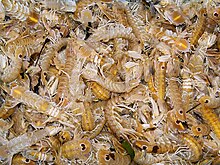Squilla mantis
| Squilla mantis | ||||||||||||
|---|---|---|---|---|---|---|---|---|---|---|---|---|

Squilla mantis |
||||||||||||
| Systematics | ||||||||||||
|
||||||||||||
| Scientific name | ||||||||||||
| Squilla mantis | ||||||||||||
| ( Linnaeus , 1758) |
Squilla Mantis is a type of Mantis shrimp , which in shallow coastal waters of the Mediterranean Sea and the eastern Atlantic Ocean occurs. The animal is known locally as "Pacchero" in this range; its abundance has made it the only species of mantis shrimp commercially fished in the Mediterranean.
description
It was first described by Linnaeus in 1758 under the name Cancer mantis .
Individuals reach a body length of up to 200 millimeters. Among the mantis shrimp , S. mantis belongs to the “spears” , which means that the attacked prey can be pierced with the fishing shears. The body has a largely uniform brown color, set off with a white border, also brown, two eye spots at the base of the Telsons .
In the field of aquaristics, other species, which can also include "butterflies", are sold under the collective term Squilla mantis .
Habitat and ecological relationships
S. mantis inhabits the coast of the Mediterranean Sea and adjacent warm parts of the eastern Atlantic Ocean. The usual biotope has muddy and sandy soils in which the dwelling caves are dug. During the day the animals remain in these caves, which are only left at night for hunting and on winter nights for reproduction.
The species can be found along the entire Mediterranean coast and in the Atlantic from the Gulf of Cadiz southwards to Angola , as well as around the Canary Islands and Madeira . In historical times there have been finds in the Bay of Biscay and around the British Isles, but recent evidence of an occurrence in these areas is lacking. Large populations occur particularly when rivers with large inflow volumes flow into the sea in an area with soils suitable for digging. In the Mediterranean, this is the case at the mouths and deltas of the Nile , Po , Ebro and Rhône .
The Knallkrebsart Athanas amazon is often found in the S. mantis dug burrows, although the snapping shrimp has a similar size as the prey spectrum of S. mantis occurring species. The extent to which these two species live together in a symbiotic, commensal or otherwise organized manner is unknown, although a similar case is known between the species Athanas squillophilus (cave dwelling) and Oratosquilla oratoria (cave tomb) in Japanese waters.
fishing
S. mantis is the only native mantis shrimp that is fished in economically relevant quantities in the Mediterranean. The annual catch taken in Europe was 6,441 tonnes in 2015, around 82% of which were landed in Italy . Outside the Mediterranean region (Andalusia, Gulf of Cádiz coast), the animals are sold under the name "Galeras" and in the kitchen.
Individual evidence
- ↑ WoRMS, (Dr. Jacob van der Land) : WoRMS - Squilla mantis ( English ) WoRMS. December 21, 2004. Retrieved January 1, 2018.
- ↑ a b Cédric d'Udekem d'Acoz: Squilla mantis . In: Crustikon - Crustacean photographic website . Tromsø Museum - University of Tromsø . 2003. Archived from the original on October 14, 2008. Retrieved on December 31, 2017.
- ^ Roy Caldwell: External anatomy and explanatory notes . In: Roy's List of Stomatopods for the Aquarium . University of California Museum of Paleontology . Retrieved August 26, 2007.
- ^ Wolfgang Schneider: Stomatopods . In: Field Guide to the Commercial Marine Resources of the Gulf of Guinea (PDF), FAO Regional Office for Africa, 1990, ISBN 92-5-103048-0 , p. 191. ( Page no longer available , search in web archives ) Info : The link was automatically marked as broken. Please check the link according to the instructions and then remove this notice.
- ↑ Mantis shrimp . togar.de. Retrieved January 1, 2018.
- ↑ a b c F. Maynou, P. & P. Abelló Sartor: A review of the biology of the fisheries mantis shrimp, Squills Mantis (L., 1758) (Stomatopoda, Squillidae) in the Mediterranean . In: Crustaceana . 77, No. 9, 2004, pp. 1081-1099. doi : 10.1163 / 1568540042900295 .
- ↑ C. Froglia, R. James & A. Atkinson: Association between Athanas amazone (Decapoda: Alpheidae) and Squilla mantis (Stomatopoda: Squillidae) . In: Journal of Crustacean Biology . 18, No. 3, 1998, pp. 529-532. doi : 10.2307 / 1549417 .
- ↑ K.-I. Hayashi: A new species of the genus Athanas (Decapoda, Caridea, Alpheidae) living in the burrows of a mantis shrimp . In: Crustaceana . 75, No. 3-4, 2002, pp. 395-403. doi : 10.1163 / 156854002760095462 .
- ↑ Global Production Statistics . Food and Agriculture Organization . Retrieved January 1, 2018.

